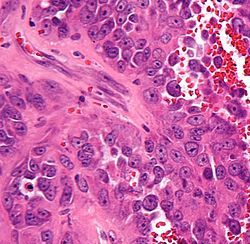Chemoradiation and Radiation Produced Similar Outcomes in Extremity Soft Tissue Sarcoma
Researchers at Istanbul University Institute of Oncology have concluded that patients with high-risk extremity soft tissue sarcoma have similar 3-year outcomes whether they are assigned to neoadjuvant sequential chemoradiotherapy or radiation alone.
sarcoma

Researchers at Istanbul University Institute of Oncology have concluded that patients with high-risk extremity soft tissue sarcoma have similar 3-year outcomes whether they are assigned to neoadjuvant sequential chemoradiotherapy or radiation alone. The findings were published in Contemporary Oncology.
The 3-year overall survival (OS) rate was 74.1% in the chemoradiation arm versus 90.0% in the radiotherapy (RT) arm (P = .44). At a median follow-up of 37 months, rates for disease-free survival (DFS), local recurrence-free survival, and distant recurrence-free survival rates did not differ significantly per treatment arm. Investigators said low event rates and the small size of the groups precluded comparison of outcomes.
“Preoperative hypofractionated radiotherapy alone or sequentially with chemotherapy result in high rates of limb salvage and acceptable toxicity,” concluded the investigators, led by Leyla Kılıç, MD, Department of Medical Oncology, Institute of Oncology, Istanbul University, Istanbul, Turkey. “Our study results did not show a statistically significant treatment effect regarding survival and patterns of failure.”
For the entire cohort (N = 67), the OS rate was 79% (95% CI, 67.0-86.4) and the DFS rate was 57.9% (95% CI; 46.3-69.0). Investigators found no statistically significant predictors for OS or DFS; however, there was a statistically nonsignificant trend toward better OS and DFS for women, elderly patients, and/or those with tumors ≤10 cm.
The response rate for chemotherapy was 20%. Overall, 25 patients (37.3%) had disease progression: 11 (16.4%) had isolated distant metastasis; 10 (14.9%) had locoregional failure; and 4 had failure at both local and distant sites. The most common site of metastasis was lung (n = 13). Sites of progression did not show statistically significant differences with respect to the neoadjuvant treatment.
Kılıç et al cautioned that, because of its small sample size and the uneven distribution of patients across the treatment arms, this study is not statistically powered to detect small to intermediate beneficial effects of chemotherapy for a specific subgroup.
Previous study results have shown that adding adjuvant or neoadjuvant radiation to surgery improves local control in extremity soft tissue sarcoma. Physicians often add chemotherapy in patients at high risk for distant metastases, but there is little prospective data comparing neoadjuvant sequential chemoradiotherapy with RT alone. The investigators conducted a retrospective analysis of patients treated at Istanbul University to assess outcomes associated with both treatment modalities.
Eligible participants had a WHO performance score of 0 to 2 and appropriate bone marrow. Primary tumors ≥8 cm or ≥4 cm and grade 2 or 3 according to the NCI 3-tier grading system were classified as high risk.
Patients with locally recurrent and limited metastatic tumors treated with neoadjuvant modalities were not included in the analysis. Patients with rhabdomyosarcoma, primitive neuroectodermal tumors, extraosseous Ewing sarcoma, chondrosarcoma, osteosarcoma, Kaposi sarcoma, and sarcoma of the head and neck or trunk were also excluded.
Thirty-four patients were treated with neoadjuvant sequential chemotherapy: 2 to 3 cycles of doxorubicin (75 mg/m2 IV) on day 1, followed by 2 g/m2 ifosfamide on days 1 to 3. Roughly 4 in 5 patients in the chemotherapy arm underwent 2 cycles of treatment; 21% underwent 3 cycles.
Thirty-three patients were assigned to 28 Gy external beam RT administered as 8 fractions of daily 3500 cGy for 10 days. Radiation therapy was initiated 3 weeks after the second or third chemotherapy cycle.
Patients with positive surgical margins received a postoperative RT boost of 12 Gy administered in 6 daily fractions of 2 Gy. The boost was administered beginning 2 weeks after resection after satisfactory healing of the surgical wound. A specialized team performed surgery 2 to 3 weeks following the last RT dose.
The most common nonhematological adverse events among all patients were nausea and/or vomiting. Twelve patients (35%) required dose reductions, mostly due to febrile neutropenia and grade 4 thrombocytopenia. All patients completed the planned RT schedule, and there were no toxicity-related deaths in either group.
Krisha Howell, MD, assistant professor in the department of radiation oncology at Fox Chase Cancer Center, reviewed the data for OncLive. Although the study did not show an improvement in outcomes for chemotherapy, these results “must be taken in context of larger prospective trials and meta-analysis, which give greater information to the toxicity profiles and outcomes of larger patient populations.”
“At the end of the day, radiation therapy in the setting of limb-sparing resection demonstrates good local control with or without chemotherapy,” she said. “And each patient, as an individual, needs to be assessed as to the relevance of chemotherapy for their cancer as it is highly dependent on staging and histologic subtypes."
Kılıç L, Ekene M, Karabulut S, Ağaoğlu F, Darendeliler E. Neoadjuvant sequential chemoradiotherapy versus radiotherapy alone for treatment of high-risk extremity soft tissue sarcoma: a single-institution experience. Contemp Oncol. 2017;21(1):60-65. doi:10.5114/wo.2017.66658.



